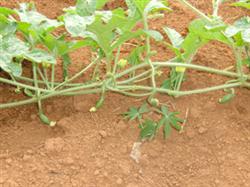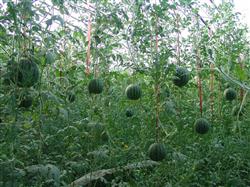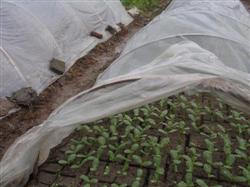Three elements of watermelon flower and fruit protection in high temperature and rainy season

The hot and rainy season is a test for most crops, and watermelon is no exception. In this weather, what we mainly do is how to protect flowers and fruits and improve fruit setting rate and watermelon yield. The protection is mainly carried out from three aspects: factor 1, cultivation and management in the greenhouse 1. In the hot summer, due to the rapid evaporation of water in the greenhouse, the water demand is very large, while the muskmelon is ripe and on the market at this time, too much water will lead to the decline of quality or cracking of melons; therefore, the field should strictly control the watering time and water according to the specific conditions. It is best to use drip irrigation facilities when watering, using small water irrigation frequently to prevent cracking; do not water three days before harvest, so as not to affect the quality of melons and fruits. 2. Timely harvest and listing, and timely selection of second stubble melons. Factor 2, open field cultivation management 1. Summer is the season with high incidence of torrential rain, so be sure to clear ditches and drainage in the field in time. 2. Timely artificial pollination, flower and fruit protection: seedless watermelon is artificially pollinated at 6-8 o'clock in the morning in sunny days, paper cap and flower cover can be used in rainy days, and seeded watermelons can also be artificially pollinated. Laying grass under young melons before rainstorm can effectively prevent fruit drop caused by rainstorm. Factor 3, pest control 1, epidemic disease: at the initial stage of the disease, the disease department or root irrigation can be sprayed. The commonly used agents are 58% Ruidu manganese zinc wettable powder 500-800 times liquid, or 40% ethyl phosphate aluminum (Phytophthorin) wettable powder 200-250 times liquid, or 64% poison alum wettable powder 400-600 times liquid. It is generally sprayed or irrigated with root every 7-10 days, and the medicine is used 2-3 times continuously. 2. Virus diseases: control aphids and prevent diseases, timely control aphids; diseased plants found in the field should be removed and destroyed in time to prevent virus transmission. At the initial stage of the disease, spray 25% virus K1000 times, or 20% virus A wettable powder 500 times, or 5% fungus EC 800Mel 1000 times, or 0.5% antiviral agent 1 (mushroom proteoglycan) 300 times, once every 7-10 days, 2-3 times in succession, to reduce the harm. 3. Anthrax: spray 75% chlorothalonil wettable powder, or 50% methyl topiramate wettable powder, or 50% carbendazim wettable powder, or 10% high water dispersible granule 3000-6000 times, every 7-10 days, for a total of 2-3 times. Continuous rainy weather should seize the time to spray when the rain stops. In general, it is effective if it doesn't rain 5 hours after spraying, and you can't wait for sunny weather to prevent and cure it, so as not to delay the time. 4. Fusarium wilt: after diseased plants were found in the field, the diseased plants were pulled out in time at the initial stage of the disease, and the roots of the diseased plants and the roots of several plants before and after the disease were disinfected by spraying quicklime or chemical irrigation. The commonly used medicaments are 50% Sukeling 1200 times liquid, or 50% propofol wettable powder 1000 rain 1200 times liquid, or 50% topiramine wettable powder 500 times liquid, or 50% carbendazim wettable powder solution 600,800 times, or 40% guacunin wettable powder 1000 times liquid, 0.250.5kg per plant, once every 5-7 days, 2-3 times in a row. 5, aphids, red spiders: 10% imidacloprid 1000 times spray, or 2.5% cyhalothrin EC 4000 times or 48% Lexben 1000 times spray, once every 5-7 days. 6. Huangshou melon: cultivated with plastic film mulching, plant ash and sawdust were sprinkled around the stem base of melon seedlings to prevent adults from laying eggs at the roots of melon seedlings. Chemical control of adults can be sprayed with 2.5% deltamethrin EC 3000 times, or 10% cypermethrin EC 3000 times or thoroughly 2000 times. The control of larvae can be irrigated with 1000 times of 90% crystal trichlorfon, or 500 times of 5% fish rattan essential EC, or 30-40 times of tobacco extract. As can be seen from the above, the flower and fruit protection of muskmelon is mainly managed from protected field and open field cultivation, and always pay attention to the protection of diseases and insect pests during the growth process, so as to deal with the problem in real time, which can increase the yield and increase the yield and income for fruit growers.
- Prev

Strengthen the field management of watermelon at present
At present, the corresponding field management of watermelon should take the following measures: 1. Open a good drainage and irrigation ditch: if the trench does not meet the requirements before planting, the general ditch, perimeter ditch, middle ditch and border ditch should be opened in time. The depths of the grooves are 1.5 m for the total trench, 1.0 m for the middle ditch, 0.8 m for the middle ditch and 0.4 m for the border ditch. The trench must be unobstructed.
- Next

Key measures for raising watermelon seedlings in winter
In order to improve the heat preservation and heating measures of the seedling shed, the heat preservation and non-performance can be greatly improved by using polycyanoethylene non-dripping film instead of polyethylene film, and the greenhouse temperature can be increased by 1-2 degrees. Temporary heating equipment such as fire wall or heating furnace should be installed in the shed. Artificial warming should be carried out when necessary. 1. Watermelon and rootstock seeds were treated at low temperature.
Related
- Moge, come on! The staff of the peasant association in the producing area of cantaloupe were frightened when the crowd gathered.
- Causes and Solutions of low Fruit setting rate of Apple
- Symptoms and control measures of passion fruit virus disease
- Fruit growing lesson: how do apple orchards keep high yields?
- Can you build orchards in the mountains? What are the pros and cons?
- How to manage the coloring period of Crisson grape?
- This paper introduces the processing technology of two kinds of fig products.
- How much is a month for retired teachers in rural areas by 2020?
- How can strawberry planting increase sugar content? We should pay attention to management in many aspects.
- What are the cultivation techniques on how to improve the yield of golden fruit?

